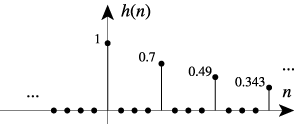Echo
An echo effect can be obtained for audio signals by realizing the following difference equation,
y(n) = x(n) + a y(n-N),
where the (discrete-time) audio input is x, the output is y, and 0 <= a < 1 is a real constant and N is an integer constant in the set Naturals. Together, a and N determine how long the echo lasts and what it sounds like. Here are some examples, where x is an audio signal with 8000 samples per second:
The impulse response h can be obtained by simply letting the input be an impulse, x = δ, and finding the output y = h. The result is, for all n in the integers,
h(n) = ∑(k=0 to infinity) ak δ(n-kN).
The impulse response is plotted below:


 Up to Topics
Up to Topics Previous
Previous Next
Next